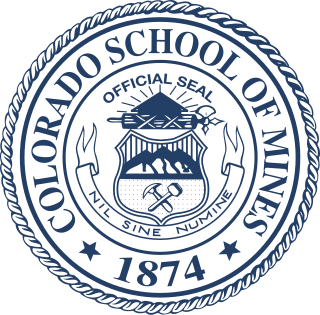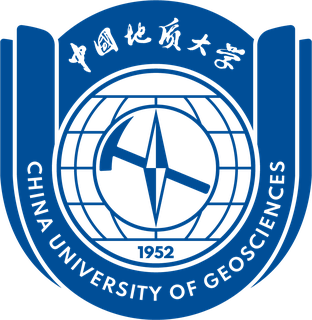
The University of Nevada, Reno is a public land-grant research university in Reno, Nevada. It is the state's flagship public university and primary land grant institution. It was founded on October 12, 1874, in Elko, Nevada.

The Colorado School of Mines (Mines) is a public research university in Golden, Colorado, founded in 1874. The school offers both undergraduate and graduate degrees in engineering, science, and mathematics, with a focus on energy and the environment. While Mines does offer minor degrees in the humanities, arts, and social sciences, it only offers major degrees in STEM fields, with the exception of economics. In the Fall 2022 semester, the school had 7,408 students enrolled, with 5,733 in an undergraduate program and 1,675 in a graduate program. The school has been co-educational since its founding, however, enrollment remains predominantly male. It is classified among "R1: Doctoral Universities – Very high research activity".

Mining in the engineering discipline is the extraction of minerals from underneath, open pit, above, or on the ground. Mining engineering is associated with many other disciplines, such as mineral processing, exploration, excavation, geology, and metallurgy, geotechnical engineering and surveying. A mining engineer may manage any phase of mining operations, from exploration and discovery of the mineral resources, through feasibility study, mine design, development of plans, production and operations to mine closure.

The Royal School of Mines comprises the departments of Earth Science and Engineering, and Materials at Imperial College London. The Centre for Advanced Structural Ceramics and parts of the London Centre for Nanotechnology and Department of Bioengineering are also housed within the building. The school as an organisation no longer exists, having been incorporated into the Faculty of Engineering since 2003. Today the Royal School of Mines refers to both the departments associated with the former school, and the Grade II listed Edwardian building by Sir Aston Webb, which is viewed as a classic of academic architecture. The building and relevant student union still carry the name.

Indian Institute of Technology, Dhanbad is a public technical university located in Dhanbad, India. It has main campus of 393 acres in Sardar Patel Nagar area of Dhanbad and recently Jharkhand Cabinet approved 226.98 acres of land in Nirsa for its second campus, IIT (ISM) Dhanbad administration has plans to open more than 29 academic centers in this upcoming campus in Nirsa, Dhanbad. It is an Institute of National Importance. IIT Dhanbad is ranked among the most prestigious academic institutions in India.

The W. M. Keck Foundation is an American charitable foundation supporting scientific, engineering, and medical research in the United States. It was founded in 1954 by William Myron Keck, founder and president of Superior Oil Company. The Foundation's net assets exceeded $1.3 billion at the end of 2019.

Empire Mine State Historic Park is a state-protected mine and park in the Sierra Nevada mountains in Grass Valley, California, U.S. The Empire Mine is on the National Register of Historic Places, a federal Historic District, and a California Historical Landmark. Since 1975 California State Parks has administered and maintained the mine as a historic site. The Empire Mine is "one of the oldest, largest, deepest, longest and richest gold mines in California". Between 1850 and its closure in 1956, the Empire Mine produced 5.8 million ounces of gold, extracted from 367 miles (591 km) of underground passages.

Camborne School of Mines, commonly abbreviated to CSM, was founded in 1888. Its research and teaching is related to the understanding and management of the Earth's natural processes, resources and the environment. It has undergraduate, postgraduate and research degree programmes within the Earth resources, civil engineering and environmental sectors. CSM is located at the Penryn Campus, near Falmouth, Cornwall, UK. The school merged with the University of Exeter in 1993.

National Research Tomsk Polytechnic University (TPU) is a technical university in Russia. TPU was a member of 12 international associations, including the Conference of European Schools for Advanced Engineering Education and Research (CESAER) until it was suspended in March 2022, and the European University Association (EUA) until it was suspended in March 2022. TPU was included in Project 5-100, a 2013 state program aimed at bringing at least five Russian universities from among the project participants into the 100 best universities in the world.

Galena is an abandoned town in Washoe County, Nevada, south of Reno. The portion of Reno just south of Mount Rose Highway and west of Steamboat Springs is also known as Galena.
There are several notable research and academic institutes, centers and facilities associated with the University of Nevada, Reno.

The Dnipro University of Technology, abbreviated in Ukrainian as NTU DP is located in Dnipro, the third most populous city in Ukraine. It was founded in 1899 as the Yekaterinoslav Higher Mining School. The task of the university then was to provide the mining industry with highly qualified specialists, a goal that has continued to direct the university's leadership right up to the present day, although in recent years its academic offer has developed beyond the confines of mining-related subjects. Currently, its structure consists of nine faculties. During the Soviet era, the polytechnic was one of the country's top specialised institutions of higher education. It is ranked as one of Ukraine's best universities in many rankings and today attracts a large number of foreign students.

University of Nevada Reno Historic District on the campus of the University of Nevada, Reno is a 40-acre (16 ha) historic district that was listed on the National Register of Historic Places (NRHP) on February 25, 1987. It includes works by architects Stanford White and Frederick J. DeLongchamps. It includes 13 contributing buildings and two other contributing structures, including two separately NRHP-listed buildings, the Mackay School of Mines Building and Morrill Hall. The 13 historic buildings are:
James Vladimir Taranik was an American scientist and educator who worked in the area of earth-observation satellite remote sensing. He was Chief of NASA's Non-Renewable Resources Branch and Program Scientist of the Space Shuttle's first scientific flights with cargo that included experiments related to geology, atmospheric chemistry, meteorology, marine biology, and plant physiology in the earth and life sciences. He also held various positions in the Nevada System of Higher Education, including the Desert Research Institute and the Mackay School of Earth Sciences and Engineering.

The Nevada Bureau of Mines and Geology (NBMG) is a research and public service unit of the University of Nevada and the State Geological Survey. NBMG is also part of the Mackay School of Earth Sciences and Engineering at the University of Nevada in Reno. Scientists with the NBMG conduct research and publish their findings around topics which include, mineral and energy resources, engineering geology, environmental geology, earthquakes, groundwater, and geologic mapping in Nevada. In addition, the NBMG provides special services in the field of analytical geochemistry and assay standards, mineral and rock identification. The NBMG provides earth-science education and in-service teacher training and continuing education for professional geoscientists, geologic and geotechnical information.
Wahmonie was a mining town in Nevada. It was established as a gold mining camp in February 1928 and had a population of 500 by March. Peak population was reached that summer, with between 1000 and 1500 residents. Gold was not found in sufficient quantity to sustain the place, and the site was quickly abandoned. The post office was in operation from April 1928 until April 1929. Wahmonie was the last large mining rush in Nevada. The location was also known as Horn Silver Mine.

The China University of Geosciences (Beijing) (Chinese: 中国地质大学(北京); abbreviated CUGB or 北京地大) is a public research university located in Haidian District in Beijing. It is a key national university of China and a Double First Class university listed by the Chinese Ministry of Education. The university is under the direct administration of the Ministry of Education and also holds a partnership with the Ministry of Natural Resources of China.

Geological engineering is a discipline of engineering concerned with the application of geological science and engineering principles to fields, such as civil engineering, mining, environmental engineering, and forestry, among others. The work of geological engineers often directs or supports the work of other engineering disciplines such as assessing the suitability of locations for civil engineering, environmental engineering, mining operations, and oil and gas projects by conducting geological, geoenvironmental, geophysical, and geotechnical studies. They are involved with impact studies for facilities and operations that affect surface and subsurface environments. The engineering design input and other recommendations made by geological engineers on these projects will often have a large impact on construction and operations. Geological engineers plan, design, and implement geotechnical, geological, geophysical, hydrogeological, and environmental data acquisition. This ranges from manual ground-based methods to deep drilling, to geochemical sampling, to advanced geophysical techniques and satellite surveying. Geological engineers are also concerned with the analysis of past and future ground behaviour, mapping at all scales, and ground characterization programs for specific engineering requirements. These analyses lead geological engineers to make recommendations and prepare reports which could have major effects on the foundations of construction, mining, and civil engineering projects. Some examples of projects include rock excavation, building foundation consolidation, pressure grouting, hydraulic channel erosion control, slope and fill stabilization, landslide risk assessment, groundwater monitoring, and assessment and remediation of contamination. In addition, geological engineers are included on design teams that develop solutions to surface hazards, groundwater remediation, underground and surface excavation projects, and resource management. Like mining engineers, geological engineers also conduct resource exploration campaigns, mine evaluation and feasibility assessments, and contribute to the ongoing efficiency, sustainability, and safety of active mining projects

















